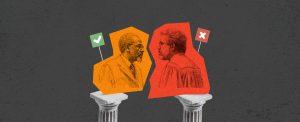The theme of Ascend Magazine this month is the regulator of the future. My editor’s briefing to me was to be creative and imaginative, and to have a bit of fun in ‘building’ my future regulator. I immediately thought about that famous toy with hundreds of different plastic bricks and pieces that can be put together to form pre-determined things like objects, vehicles, iconic buildings (my favorite range), or anything your imagination wants. It is the idea of fun and creativity in my family.
So, in imagining the regulator of the future, could I build it with those LEGO® bricks? There are some parallels that I could draw or piece together (pun intended!).
I would start my build with the foundation bricks. This is the part that some of us find boring because there is not a shape yet and the pieces are plain. But it is an important part to sustain what comes next. In my view, the regulator of the future shall continue to have a solid foundation and mandate to protect the public, consumers, and the environment.
After building the foundations, it is time to risk assess whether the next layer can be added on top and what should come first. We start to add elements that will give shape and show the format of what we are building, for example, walls of a house or the body of a car. These are the necessary parts to have the expected result and then to be able to include further add-ons. The core regulatory functions of my future regulator, the basic pieces to deliver its mandate. For example, ensuring that standards of behavior and competence are set and met by those practicing a regulated activity; and having a disciplinary procedure to address shortfalls and protect the public. Functions founded on building blocks of effective policies and procedures.
The fun part of having my future regulator built of stackable bricks is the flexibility it gives me. If a core piece is too rigid, wobbly, or no longer suits my current needs, I can just replace it for another piece that is more fit for purpose. My future regulator has the flexibility to adapt to challenges and opportunities. It has the power to periodically review its frame and access a ‘box of bricks and pieces’ that it could use when required to achieve regulatory outcomes without delay. The future will continue to be of rapid and constant change so my future regulator will have to change, adapt, and reshape constantly.
My favorite part of this game is adding the final parts, particularly when they bring some technological advance. For example, an app-controlled transformation vehicle, a toy helicopter that can fly, or a robot that can emit sounds and light its eyes.
My future regulator will have all the latest technology that it needs to be more efficient, more effective, and focused on its core mandate. This includes the safe and ethical use of artificial intelligence to optimize processes, assess risks, detect wrongdoing, identify patterns and precedent, among many other possibilities and benefits that AI will continue to bring.
As with the toy that I am using to build my future regulator, it will also have access to the instructions for any AI tool or system it uses when it needs clear explanations for the decisions ‘the machine’ makes, to ensure appropriate transparency and fairness. It will use data to inform decision-making and have the best data analytics capabilities to demonstrate why it needs to adapt and use its ‘box of bricks and pieces’ to change a function or an approach to deliver better outcomes.
I have now finished building the structure of my future regulator so I can start adding the people who will run it and the surroundings (like in the city setting). I have selected a diverse set of people-like figures that truly represents the society my future regulator operates in and its customers. They are proficient in a range of different skills and were ‘set’ to deliver compassionate regulation, consider the impact of their work on others, and engage with all relevant stakeholders (my surroundings) to ensure that they are listening and responding to challenges as part of a well-functioning ecosystem working in the public interest.
This lighthearted article about my future regulator comes with huge respect and admiration for the work of current regulators, not always recognized. In my engagement with some, I can see that the above is already on track and by no means is it an exhaustive list of everything needed. The future where regulators are technologically advanced – equipped with the latest data analytics and artificial intelligence capabilities to deliver risk-based, compassionate, and outcome-focused regulation – is not distant. Let’s hope that they can also have the flexibility to adapt and change to the challenges and opportunities ahead.
Rick Borges writes on regulation and related topics in financial services. With his extensive experience spanning the financial services and health care sectors, he acted as an advisor on professional standards and regulation to organizations in the U.K. and internationally.
MORE VOICES ARTICLES

Trust on trial: Navigating the murky waters of scientific integrity
As fraudulent research papers flood academic journals, the sanctity of scientific discovery is under siege, challenging the very foundation of trust we place in peer-reviewed publications. With AI now both a tool for creating and detecting such deceptions, the urgency for a robust, independent regulatory framework in scientific publishing has never been greater.

Do regulators deserve deference?
In a pivotal moment for regulatory law, the U.S. Supreme Court’s review of the Chevron doctrine could redefine the bounds of deference courts give to regulatory agencies, potentially inviting more challenges to their authority. This critical examination strikes at the heart of longstanding legal principles, signaling a significant shift in the landscape of regulatory oversight and its interpretation by the judiciary.

From Frankenstein to Siri: Accountability in the era of automation
As AI advances in sectors from health care to engineering, who will be held accountable if it causes harm? And as human decision-makers are replaced by algorithms in more situations, what will happen to uniquely human variables like empathy and compassion? Harry Cayton explores these questions in his latest article.

Regulating joy: The risky business of festivities
In his final Voices article of 2023, Harry Cayton reflects on our enthusiasm for participating in cultural festivities that often cause injuries or even deaths, which has led some governments to attempt to regulate these risky celebrations.

Building my regulator of tomorrow with LEGO® bricks
What should the regulator of tomorrow look like? While there may be no definitive vision, contributor Rick Borges gets creative with answering this important question, drawing inspiration from a favorite toy to ‘build’ a model of an effective future regulator.

‘Thin’ and ‘thick’ rules of regulation: Cayton reviews Daston’s history of what we live by
Lorraine Daston explores fascinating examples of rulemaking throughout history in her new book, ‘Rules: A Short History of What We Live By.’ In this article, Harry Cayton discusses what regulators can learn from Daston’s work.








